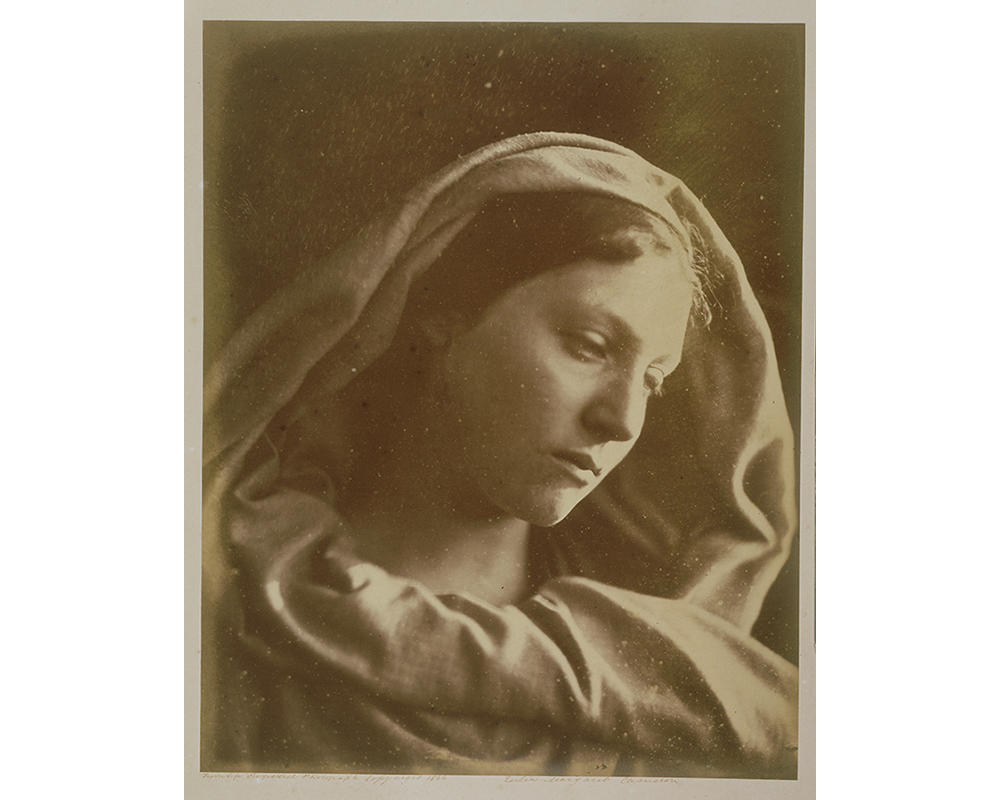
Student Perspective: Julia Margaret Cameron's Photographs
Guest blogger Robin Acker AC ’12 is a student assistant in the Cunningham Center for the Study of Prints, Drawings and Photographs.
I began working at the Cunningham Center as a student assistant when I entered Smith College as an Ada Comstock Scholar in the autumn of 2009. I had recently researched the photographic artist Julia Margaret Cameron, who was the aunt of Julia Stephen and the great-aunt of her daughter, Virginia Woolf. As a non-traditional student, I was impressed by Cameron's life because she began her career during her middle-aged years. She produced an enormous body of photographic art that included significant portraits of Victorian authors, artists, and scientists such as Alfred Tennyson, William Holman Hunt, and Charles Darwin. She created studies of women depicted as biblical and classical literary figures, along with images for Tennyson’s Idylls of the King - often developing her own soft focus and dramatic lighting techniques that were advanced for the time. Her passion for gathering a community of creative intellectuals on the Isle of Wight, near London, was a precedent for the Bloomsbury Group in which her great-niece, Virginia Woolf would one day take part. When I decided to complete my college education at nearly 50 years of age, Julia Margaret Cameron became my inspiration.
The Cunningham Center houses over 16,000 works on paper that includes over 5,000 photographs by artists such as Edward Weston, Alfred Stieglitz, Robert Doisneau and hundreds of others – including Julia Margaret Cameron. When students begin their assistant positions here, the first thing that they are taught to do is to handle the objects in the collection correctly in order to prepare them for viewing by individuals, students, professors, and classes from local schools and colleges. Curator Aprile Gallant and Manager Henriette Kets de Vries carefully emphasize that these objects are to be used – not merely stored – in the Cunningham Center. That means that when you visit here by appointment, we have placed up to 15 objects of your choice on the tables in the study room for your own private viewing – you may not touch, but your use of a magnifying glass is encouraged! You may take your time to browse the objects, research the files, ask the staff questions, and even choose to make another appointment to view more objects. It is an unusually rare and fortunate opportunity in a museum environment to work so closely with museum objects and many people are unaware of its availability.
My experience as a student assistant at the Cunningham Center has been extraordinary. I have been privileged to work with some of the most fascinating objects in the museum and to do so with an opportunity to research and study them, as well. In my first few days here, I tentatively asked – did the Cunningham Center own any of Julia Margaret Cameron’s photographs? Yes, they did, I was told. Could I see them, I wondered? Yes, I was assured, of course I could. This left me so overwhelmed with emotion that I went home that afternoon and telephoned my favorite family and friends (who had all been subjected to many conversations with me regarding all things Julia Margaret Cameron) and told them this news. I was going to actually see several of Julia Margaret Cameron’s photographs at the Cunningham Center! When I returned the next day, I reverently brought Mother Mary (Mary Hilliers) out from its storage location and set it on the table in the study room. I was so moved that I found my eyes quickly filling up with tears and I smiled in embarrassment when Aprile and Henriette found me there. I said I was sorry to be so silly. They smiled back and said that it was perfectly okay, as long as I didn’t get tears on the photograph. We laughed together and I composed myself. Aprile said that one of Julia Cameron’s photographs would be on view in our Nixon Gallery soon and Henriette asked me if I would like to write the label for it. I said yes, but by then I was undone. So, I resumed my crying with much happiness, making sure that I didn’t spill any tears on my beloved Julia’s photograph.